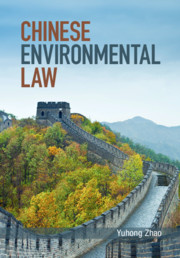Book contents
- Chinese Environmental Law
- Chinese Environmental Law
- Copyright page
- Contents
- Detailed Contents
- Tables
- Preface
- Author’s Note
- Weights and Measures
- Statutes
- Regulations and Measures
- Judicial Interpretations
- State Plans and Party Policies
- Table of Cases
- Table of Treaties
- Abbreviations
- Abbreviations of Legal Instruments
- 1 Environmental Problems and Legal Responses
- 2 Key Institutions of Environmental Protection
- 3 The Environmental Protection Law
- 4 Environmental Impact Assessment
- 5 Regulation and Control of Air Pollution
- 6 Regulation and Control of Water Pollution
- 7 Waste Management
- 8 Soil Contamination
- 9 Environmental Tort
- 10 Judicial Review
- 11 Environmental Crimes
- 12 Environmental Public Interest Litigation
- Bibliography
- Index
9 - Environmental Tort
Published online by Cambridge University Press: 16 June 2021
- Chinese Environmental Law
- Chinese Environmental Law
- Copyright page
- Contents
- Detailed Contents
- Tables
- Preface
- Author’s Note
- Weights and Measures
- Statutes
- Regulations and Measures
- Judicial Interpretations
- State Plans and Party Policies
- Table of Cases
- Table of Treaties
- Abbreviations
- Abbreviations of Legal Instruments
- 1 Environmental Problems and Legal Responses
- 2 Key Institutions of Environmental Protection
- 3 The Environmental Protection Law
- 4 Environmental Impact Assessment
- 5 Regulation and Control of Air Pollution
- 6 Regulation and Control of Water Pollution
- 7 Waste Management
- 8 Soil Contamination
- 9 Environmental Tort
- 10 Judicial Review
- 11 Environmental Crimes
- 12 Environmental Public Interest Litigation
- Bibliography
- Index
Summary
Chapter 9 examines environmental torts with a focus on the special rules and doctrines developed since the 1980s and under the Tort Law (2009) and relevant judicial interpretations of the SPC. Although most pollution-triggered disputes are resolved by mediation, courts offer the crucially important last resort for China’s most aggrieved and stubborn victims of pollution to seek remedies. Their efforts in seeking access to justice have helped shaping and reforming the rules and practice of environmental tort law to address the difficulties in the collection of evidence, assessment of damage, case acceptance by court, and enforcement of judgment. The chapter starts with exploration of the long journey to establish the rule of no-fault liability as an exception to the conventional fault-based liability by both judicial interpretation and legislation. It then examines the causal link between defendant’s acts and plaintiff’s loss or injury and the rule on the shift of burden of proof from plaintiff to defendant. As environmental torts often involve multiple tortfeasors and large number of victims, the chapter further investigates forms of liability among multiple tortfeasors, class action and remedies. It concludes with discussion of judicial mediation as a preferred option for settling disputes in court.
Keywords
- Type
- Chapter
- Information
- Chinese Environmental Law , pp. 308 - 336Publisher: Cambridge University PressPrint publication year: 2021

